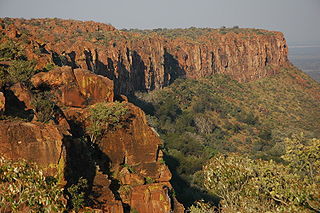This is a list of fossiliferous stratigraphic units in Zimbabwe .
This is a list of fossiliferous stratigraphic units in Zimbabwe .

The Fruitland Formation is a geologic formation found in the San Juan Basin in the states of New Mexico and Colorado, in the United States of America. It contains fossils dating it to the Campanian age of the late Cretaceous.

The Clarens Formation is a geological formation found in several localities in Lesotho and in the Free State, KwaZulu-Natal, and Eastern Cape provinces in South Africa. It is the uppermost of the three formations found in the Stormberg Group of the greater Karoo Supergroup rocks and represents the final phase of preserved sedimentation of the Karoo Basin.

The Batoka Formation is a geological formation in the Zambezi valley in Botswana, Zambia and Zimbabwe. It is predominantly a volcanic unit comprising mainly basalts. It was formerly thought to contain sand stones containing the dinosaur Vulcanodon, however this was shown to be in error resulting from interpreting folding of the rocks as separate layers, with the sandstone layers actually being from the underlying Forest Sandstone.
The Kadzi Formation is a geological formation in Zimbabwe whose strata date back to the Tithonian stage of the Late Jurassic. The conglomeratic sandstones and silty mudstones of the formation were deposited in an alluvial environment. Dinosaur remains are among the fossils that have been recovered from the formation.
The Gokwe Formation is an Early Cretaceous geologic formation in Zimbabwe. Dinosaur remains are among the fossils that have been recovered from the formation, although none have yet been referred to a specific genus. Sediments of the formation may have been laid down in a small shallow lake, carried by intermittent floods from a land surface surrounding the lake on which aeolian transport of sand took place. More likely the animals died on a dry lake bed, and their bones were exposed to a period of desiccation, later floods would scatter the fragments and incorporate them in sediment.

The Pebbly Arkose Formation is a Late Triassic geologic formation found in southern Africa.

The Irhazer Shale or Irhazer II Formation is a Middle Jurassic geologic formation of the Irhazer Group in the Agadez Region of Niger. Fossil ornithopod tracks have been reported from the formation. The dinosaur Spinophorosaurus is known from the formation.

Megapnosaurus is an extinct genus of coelophysid theropod dinosaur that lived approximately 188 million years ago during the early part of the Jurassic Period in what is now Africa. The species was a small to medium-sized, lightly built, ground-dwelling, bipedal carnivore, that could grow up to 2.2 m (7.2 ft) long and weigh up to 13 kg (29 lb).

The Ganigobis Formation is a Late Carboniferous (Gzhelian) to Early Permian (Artinskian) geologic formation of the Dwyka Group in the ǁKaras Region of southeastern Namibia and the Northern Cape of South Africa. The widespread formation was deposited in the Aranos and Karoo Basins of southern Africa.

The Whitehill Formation, alternatively written as White Hill Formation and formerly known as White Band or Whitehill or White Hill Member, is a regional Early Permian geologic formation belonging to the Ecca Group in the southeastern ǁKaras Region of southeastern Namibia and Eastern, Northern and Western Cape provinces of South Africa.

The Gai-As Formation is an Early to Middle Permian geologic formation correlated with the Ecca Group and designated "Ecca" Group, because it does not belong to the Karoo, in the southwestern Kunene Region and northern Erongo Region of northwestern Namibia. The Gai-As Formation represents the second-oldest sedimentary unit of the Huab Basin, overlying the Huab Formation. The formation was deposited in a fluvial to lacustrine setting.

The Omingonde Formation is an Early to Middle Triassic geologic formation, part of the Karoo Supergroup, in the western Otjozondjupa Region and northeastern Erongo Region of north-central Namibia. The formation has a maximum thickness of about 600 metres (2,000 ft) and comprises sandstones, shales, siltstones and conglomerates, was deposited in a fluvial environment, alternating between a meandering and braided river setting.
The Bemaraha Formation is a Middle Jurassic geological formation of the Morondava Basin of Madagascar. The lime mudstones, grainstones and limestones of the formation were deposited in lagoonal and reefal environments. Fossils of groups of invertebrates and theropod and sauropod tracks have been found in the formation. The Sahalaly River tracksite yielded a single trackway belonging to a quadrupedal dinosaur, possibly a sauropod. Sauropod tracks are rare, making up as little as 1 percent of the present sample. The best-preserved tracks are assigned to the ichnogenus Kayentapus.